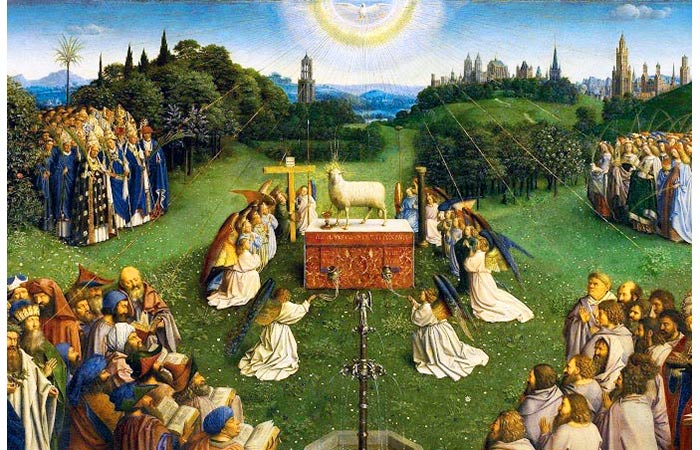Christ is not only exalted as priest; he is also exalted as king. He is a royal priest who combines in his person both roles. His kingship, like his priesthood, is heavenly. He reigns in heaven in a way that he could not on earth. In his kingdom, under his heavenly rule, is true life and prosperity. His exaltation, then, is also an exaltation to a position of effective kingship.
The word “ascension” indicates that Christ’s work was completed by his “going up” to God. The same event can also be described as Christ’s enthronement or his being seated at the right hand of the Father. There is a connection between the two ways of describing what happened to Christ at his ascension, because the royal throne was always the highest seat in the audience hall. The spatial placement expressed the role of the king. Often the seats of others in authority were also elevated, but never higher than the royal throne. In a similar way, the royal palace was placed on Mount Zion – the highest point in Jerusalem, right below the temple, the palace of God. Heaven itself, of course, was also understood to be “on high”, much higher than the highest position on earth.
Peter’s sermon on Pentecost expressed this connection between resurrection and ascension and between ascension and enthronement. In it, he explained the outpouring of the Holy Spirit as the sign of the messianic age. Speaking of Psalm 16 as a prophecy of the resurrection of Christ, he said,
This Jesus God raised up, and of that we all are witnesses. Being therefore exalted at the right hand of God, and having received from the Father the promise of the Holy Spirit, he has poured out this which you see and hear. For David did not ascend into the heavens; but he himself says,
Acts 2:32-36
‘The Lord said to my Lord, Sit at my right hand,
till I make thy enemies a stool for thy feet.’
Let all the house of Israel therefore know assuredly that God has made him both Lord and Christ, this Jesus whom you crucified.”
The way Peter passes from Christ’s resurrection to his being seated at the right hand of God indicates that he sees the resurrection and ascension as two aspects of the same event. He then quotes another messianic psalm to indicate that the Messiah, who would die but not be held by death, would ascend to the right hand of the Father (Psalm 110). That in turn would indicate that the crucified one was both Lord and Christ.
The phrase “to sit at God’s right hand” can only be understood in terms of a royal audience. When he holds audience, The King of the Universe takes his seat on the royal throne (Daniel 7:9-10) to govern his realm. After the resurrection, his Son – “one like a son of man” (Daniel 7:13-15) – sits beside him on his right hand, the position of next greatest honor and authority. For the Son to be seated at God’s right hand, then, is to be enthroned as King, King of the Universe. As a result, Christ will share the position of his Father as divine King and reign in union with him, subordinate to him but with divine authority and power.
To say that Christ is the King of the Universe is to say that he is Lord of all. No other authority in the universe is equal in right or power, nor is there any that can withstand him. “The God of our Lord Jesus Christ…made him sit at his right hand in the heavenly places, far above all rule and authority and power and dominion” (Ephesians 1:17, 20-21). At the same time, to say that he is King indicates that Christ is in a personal relationship with his subjects, especially his loyal subjects. He cares for them in justice, defending the cause of the poor, giving deliverance to the needy, and crushing the oppressor (Psalm 72). In his kingdom is life.
While Christ’s kingship is like an earthly kingship, it is a heavenly kingship, because though human he is the heavenly Son of God. In the resurrection, he was given a new kind of life that allowed his human nature to function in a heavenly way. He was thereby enabled to take a position as human that he had previously held as divine. He “returned” to the glory he had with the Father before the world. But in the process of doing so, that glory had transfigured his humanity in such a way that someone who was human could share the divine throne.
Having someone human on God’s throne does not mean that the universe is ruled by a human being rather than God or ruled in a merely human way. “By nature” Christ was united to his Father, so that not only was his divine nature one in being with the Father, but his human nature was also united with his divine nature in oneness of person, and therefore with the Father’s divine nature. By his self–lowering or humiliation, Christ’s human nature had proved itself fitted for such an exalted position, because it was the human nature of a fully obedient servant, willing even to surrender his own life in great suffering for the sake of doing the will of God (Hebrews 5:8–9). Christ’s human nature was also fully ready for such a position, because it had died and so left behind any of the restrictions that went with sharing in the life of fallen humanity. As a result, that human nature was now glorified – a perfect expression or image of the divine nature, no longer weak but strong with divine power or glory.
When Christ reigns with God the Father, therefore, the Father does not have to share his glory with any other (Isaiah 42:8; 45: 20-25). Not only is the Son fully united with his Father so that they share the same glory of their natures, but also his humanity is that of a servant, fully set on the glory of his master, transfigured so as to be a fully responsive instrument of divine action and reflection of divine glory. God, in short, can speak and act in and through the humanity of Christ without any diminishment of his glory. Therefore Christ reigns to the glory of his Father (Philippians 2:11).
The victory of the Redeemer
The enthronement of Christ is the true victory. It was not a victory in the sense of winning a combat. That happened when Christ, the obedient servant, resisted the temptations of fear, pain, and disgrace to successfully lay down his life in humility and humiliation. That also happened when Christ – the Son of God in “the likeness of sinful flesh” (Romans 8:3) – gave up that flesh to death, so that in dying he might trample down death.
Humiliation, however, led to exaltation. Dying led to rising again in new life. Christ’s enthronement was victory in the sense of taking possession of the battlefield and the kingdom. As Satan, sin, and death lay defeated, God’s kingdom was proclaimed and Christ began to reign. He was exalted in victory to a position of rule. “To this end, Christ died and lived again, that he might be Lord both of the dead and of the living” (Romans 14:9).
As a man on earth, Christ went about preaching and teaching, healing and casting out demons. As he did so, people gained considerable freedom. Christ was therefore Redeemer during his earthly ministry. Nonetheless, he was not able to be the Redeemer in a full way until after his resurrection. As millions of people would come to believe in Christ, we have only to imagine long lines of people waiting for his personal attention to realize the impracticality of an earthly ministry as the main means of our redemption.
More seriously, even though Christ’s earthly ministry brought many individuals into contact with divine power and healing, the gates of paradise were still closed, the banishment from the garden was still in effect, and the condemnation of Adam still stood. Therefore, the full blessing could not be given. Christ could not do for people all that he came to do until he had completed his priestly work by giving his life as a sacrifice for sin and presenting that sacrifice to his Father. For that he needed to be a heavenly priest.
Likewise, Christ could not reign as king on earth. The title belonged to him. As Son of David he was the rightful King of Israel, anointed by God with the Holy Spirit and power (Acts 10:38). Even more, as the divine Son of God, he was the natural Lord “of all” the whole human race and all the angelic beings as well. Nonetheless, the usurper who was ruling as prince of this world and holding its inhabitants captive had not yet been judged and cast out (John 12:31; 16:11). Nor had Christ been enthroned and given the position that was his by right.
All that changed with the resurrection and ascension. The Messiah entered into his glory, and could do so because he had suffered (Luke 24:26). He had paid the price, taken upon himself the curse, and offered the sacrifice (Luke 24:26). He had removed the barrier, pierced the veil, and entered the most holy place. He had ascended on high, had sat down at the right hand of the Father, and had been proclaimed Lord of all.
Christ had done what was needed to make available the fullness of redemption, blessing, and heavenly access. There was no longer anything to prevent him from fully taking away the sins of those who came to him and imparting to them the new life. As Lord to the glory of God the Father (Philippians 2:11), Jesus could be the Redeemer of the human race.
This description, however, is still too external to provide a full picture. In the process of taking his new position, Christ himself had changed. He was glorified or transfigured by the power of God. As a result, the fullness of redemption was in him because the new, redeemed life was his completely. Christ had been fully united to God in oneness of being. But he was now united to God in a new way in his human nature. As a result, the power and life of God filled his human nature and so glorified it. Christ now was a glorified human being, one who not only had a more direct access to God’s heavenly presence but who also was able to transmit God’s life and power more freely and directly.
The Person of the Redeemer
At the beginning of this chapter, we looked at the vision of Christ as the Lamb standing before God as Priest and sitting on the throne as King. That was the prelude to what the royal Lamb would do in bringing human history to its fulfillment and accomplishing the complete victory. The Book of Revelation continues on to unfold the “war of the Lamb”.
Those visions are preceded by letters in which the risen and ascended Lord speaks to the seven churches who represent the whole church of the redeemed and who are living on the battlefield. Those letters are introduced by a different vision of the Lord – the Lord in the midst of his people, the Lord as he is now.
Then I turned to see the voice that was speaking to me, and on turning I saw seven golden lampstands, and in the midst of the lampstands one like a son of man, clothed with a long robe and with a golden girdle round his breast; his head and his hair were white as white wool, white as snow; his eyes were like a flame of fire, his feet were like burnished bronze, refined as in a furnace, and his voice was like the sound of many waters; in his right hand he held seven stars, from his mouth issued a sharp two–edged sword, and his face was like the sun shining in full strength.
When I saw him, I fell at his feet as though dead. But he laid his right hand upon me, saying, “Fear not, I am the first and the last, and the living one; I died and behold I am alive for evermore, and I have the keys of Death and Hades.”
Revelation 1:12-18
John saw the Lord glorified, standing in the middle of the seven golden lampstands that represent the seven churches that stand in the true temple of God, the people of the new covenant (Exodus 37:17–24). He saw, in other words, the presence of the Lord on earth now, in the middle of his people. The same Lord who is with God in his heavenly throne room is also on earth in the middle of his people, bringing the heavenly presence and reign and blessing into their lives. In his person, he unites heaven and earth.
The Lord appeared as “one like a son of man,” as a human being. This phrase is taken from Daniel 7 and indicates the heavenly man who was given kingship over the earth (Daniel 7:13; Matthew 27:64). He was clothed in priestly garments, appearing as priest as well as king. His hair was like the hair of the ancient of days (Daiel 7:9), a symbol that indicates that the glory of the Father was present in him as the incarnate Son. His appearance was angelic, like the powerful heavenly messenger who came to Daniel (Daniel 10:6) – a vision so fearful that Daniel was overcome, as John himself was.
The Lord announced himself to John as the eternal one, the first and the last who had entered into time to die. He now is eternally alive, but not because he is divine. He is alive in a human nature that has died and come to life (Revelations 2:8) so that it can die no more. Because of his victory Christ now has the keys to death and Hades, opening the place of the dead to give new life to those who come to him and sharing with them his victory and his throne (Revelation 3:20-21).
The redemption is not simply an event. It is a person. It is the Lord who has himself gone through the exodus of the human race, and so contains in his own person the fullness of redeemed humanity. Christ is the incarnate one, but the incarnation was not simply intended to be the bare union of divinity and humanity in one person. The incarnation was intended to be the means to the transformation of humanity into a glorified state. As a result, the life, goodness, and power of God would be manifested in human nature. In the person of the Redeemer, humanity is divinized in the sense of “made godlike.” Redemption began with the transfiguration or transformation of the Redeemer. He is now in the midst of his people, able to share with them what he himself has become.
The Victory and Exaltation of the Redeemer – A 3 Part series, by Steve Clark
This three part series on The Victory of the Redeemer is excerpted from Redeemer: Understanding the Meaning of the Life, Death, and Resurrection of Jesus Christ, Chapter Ten, by Steve Clark © 1992, 2009. A free PDF copy of the book is available online for download from the Sword of the Spirit website. Check out other Sword of the Spirit books from the Sword of the Spirit Online Library.
Top image credit: The Adoration of the Lamb (detail), from the Ghent Altarpiece, painted by Jan van Eyck in 1432. Image in the Public Domain. Source: https://www.wikiart.org/en/jan-van-eyck/adoration-of-the-lamb-1429
Steve Clark has been a founding leader, author, and teacher for the Catholic charismatic renewal since its inception in 1967. Steve is past president of the Sword of the Spirit, an international ecumenical association of charismatic covenant communities worldwide. He is the founder of the Servants of the Word, an ecumenical international missionary brotherhood of men living single for the Lord.
Steve Clark has authored a number of books, including Baptized in the Spirit and Spiritual Gifts, Finding New Life in the Spirit, Growing in Faith, and Knowing God’s Will, Building Christian Communities, Man and Woman in Christ, The Old Testament in Light of the New.
- See articles by Steve Clark in Living Bulwark Archives



